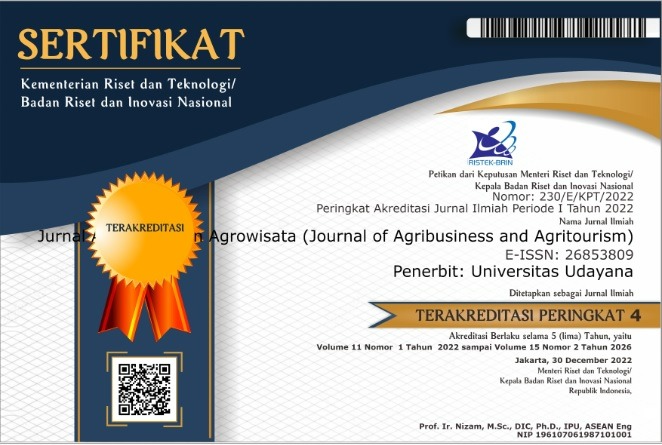Strategi Pengembangan Agrowisata Lebah Royal Honey Sakah Kecamatan Sukawati Kabupaten Gianyar
Abstract
Lebah Royal Honey Sakah Agrotourism development Strategy Sukawati District Gianyar Regency
Lebah Royal Honey Sakah Agrotourism is an agrotourism focused on education about beekeeping and honey. The purpose of the study was to identify the agro-tourism potential of the Lebah Royal Honey Sakah, Sukawati District, Gianyar Regency in terms of the 4A concept (Attraction, Accessibility, Amenity, and Ancillary) and to formulate general strategies, alternative strategies and priority strategies for developing Royal Honey Sakah bee agrotourism, Sukawati District, Gianyar Regency. Methods of data collection is done through interviews, observation and documentation. This study uses key informants determined by purposive sampling technique. Data analysis was carried out using the SWOT matrix and the QSPM matrix. The results showed that the Royal Honey Sakah bee agrotourism has the potential to be developed in terms of the 4A concept, both attraction in the form of honey, beekeeping, and education about honey. Accessibility in the form of access to the Royal Honey Sakah Bee agro-tourism is good, amenities in the form of facilities such as toilets, parking lots, and rest areas are already available. And Ancillary in the form of collaboration with the Gianyar Regency Environmental Service. Based on the research results, the general strategy for developing Royal Honey Sakah bee agrotourism is a growth strategy (Growth Strategy) and based on a SWOT matrix analysis there are seven alternatives for developing Royal Honey Sakah bee agrotourism. And based on the QSPM (Quantitative Strategic Planning Matrix) matrix, the selected priority strategy is to maintain the quality of honey as an object and a tourist attraction. So that agrotourism has the potential to be developed and introduced to the general public. The advice given for the Royal Honey Sakah bee agro-tourism development strategy is to develop agrotourism potential and apply the priority strategies that have been obtained.
Downloads
References
Jaya, F. 2017. Produk-produk lebah madu dan hasil olahannya. Universitas Brawijaya
Kotler, Philip And Gary Armstrong., 2018., Principle Of Marketing, 17e Global Edition, Pearson Education Limited, New York.
Novandra, A., & Widnyana, I. M. 2013. Peluang pasar produk perlebahan Indonesia. Balai Penelitian Teknologi Hasil Hutan Bukan Kayu, 13.
Nurdiani, N. 2014. Teknik sampling snowball dalam penelitian lapangan. ComTech: Computer, Mathematics and Engineering Applications, 5(2), 1110-1118.
Purwanto, A. 2008. Pengaruh kualitas produk, promosi dan desain terhadap keputusan pembelian kendaraan bermotor Yamaha Mio (Doctoral dissertation, Universitas Muhammadiyah Surakarta).
Rangkuti, F. 2015. Personal SWOT analysis. Gramedia Pustaka Utama.
Setiawan, I. 2015. Potensi destinasi wisata di Indonesia menuju kemandirian ekonomi. Universitas Pendidikan Indonesia.
Utama, I.G.B.R. 2015. Agrowisata Sebagai Pariwisata Alternatif. Universitas Dhayana Pura Bali. Bali.
Wulansari, D. 2018. Madu Sebagai Terapi Komplementer. Yogyakarta: Graha Ilmu.







